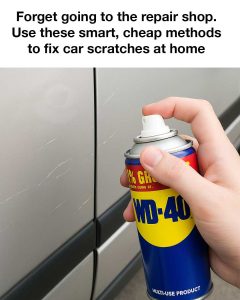Scratches on a car are something most drivers will deal with at some point. Whether it’s a faint mark from a runaway shopping cart or a more noticeable scrape caused by a tree branch or another vehicle, these imperfections can be incredibly frustrating. While professional repair services are available, they can be expensive and time-consuming, often requiring you to leave your car in the shop for days. Thankfully, many scratches—especially light to moderate ones—can be fixed at home using simple tools and inexpensive household items. Not only does this save money, but it also empowers car owners to take control of their vehicle’s appearance without relying on costly services. In this guide, we’ll explore practical, do-it-yourself methods that can help you restore your car’s finish and keep it looking great.

First, it’s important to identify the type of scratch you’re dealing with. Not all scratches are the same, and understanding the severity will determine which method is best suited for the repair. Surface scratches, for instance, only affect the outermost clear coat of the paint. These are usually the easiest to fix and can often be resolved with a light polish. On the other hand, deeper scratches that reach into the paint or even down to the metal require more involved techniques. Once you assess the damage, you can select the most appropriate solution.
To get started with home scratch repairs, you’ll need to gather a few basic supplies. A bucket, mild soap, water, sponges, and microfiber cloths are essentials for cleaning the affected area. Cleaning is a crucial first step, as dirt and debris can interfere with the repair process. Beyond cleaning tools, you may also need items like whitening toothpaste, baking soda, nail polish, WD-40, polishing compound, fine-grit sandpaper, candle wax, or even shoe polish. In some cases, you might want to purchase a dedicated scratch repair kit, which usually contains everything you need.
One of the simplest methods for handling minor scratches involves using whitening toothpaste. Because it contains mild abrasives, toothpaste can gently buff away surface-level blemishes. Begin by cleaning and drying the area thoroughly. Then, apply a small dab of toothpaste to a damp microfiber cloth and rub it gently in a circular motion over the scratch. After a few minutes, wipe off the residue and examine the results. This process may need to be repeated a few times for the best outcome.
Another handy home remedy is baking soda. When mixed with water to form a paste, it becomes a safe and effective polishing agent. Combine two parts baking soda with one part water, apply it to a damp cloth, and work it into the scratch using small circular motions. Once done, rinse the area with clean water and dry it with a fresh cloth. This method is ideal for superficial scratches on the clear coat.
WD-40, widely known for its lubricating and water-repelling properties, can also help reduce the visibility of scratches. Spray a bit onto a cloth and gently rub it across the scratch. The oils in WD-40 can temporarily fill in the scratch, making it less noticeable. However, this is not a permanent fix and should be considered a temporary cosmetic solution.
For very small chips or scratches, nail polish offers a quick fix. Select a color that closely matches your car’s paint, clean the area, and let it dry. Then, carefully apply a thin layer of nail polish directly into the scratch. Once it dries, the polish can effectively mask the damage, especially on older or less noticeable areas.
When dealing with deeper scratches, sanding and polishing might be necessary. Use fine-grit wet sandpaper to gently smooth out the area, taking care not to damage the surrounding paint. After sanding, apply a polishing compound using a clean cloth to bring back the car’s original shine. This method can deliver professional-looking results if done carefully and patiently.
In emergency situations where a temporary fix is needed, candle wax can help. Simply rub the wax over the scratch until it fills the groove, then wipe away any excess. This won’t restore the paint, but it can offer short-term protection against dirt and moisture.
If you prefer an all-in-one solution, scratch repair kits are a great option. These are sold at most auto parts stores and typically include everything from scratch removers to applicator pads. By following the step-by-step instructions included in the kit, you can tackle moderate to deep scratches with confidence and achieve long-lasting results.
An unexpected yet useful tool for scratch repair is shoe polish. This method involves using a polish in a contrasting color to your car’s paint. By applying it over the scratch, you make the blemish more visible, which helps during sanding or polishing. Once the repair is complete, be sure to clean off any remaining polish to restore the area’s natural color.
As with any DIY project, it’s important to follow safety precautions. Always work in a well-ventilated space and wear gloves if handling chemicals. Before applying any product to your car’s visible surfaces, test it on a hidden area to ensure it won’t cause additional damage. Carefully read product labels and instructions to avoid mistakes.
In conclusion, fixing car scratches at home is not only cost-effective but also surprisingly satisfying. With the right tools, some patience, and a little bit of elbow grease, you can restore your vehicle’s appearance and avoid the high costs associated with professional services. Understanding the different kinds of scratches and knowing how to properly treat them gives you the confidence to take care of your car’s exterior. By embracing these simple methods, you can keep your vehicle looking sharp and maintain its value over time—without ever stepping foot in a repair shop.





